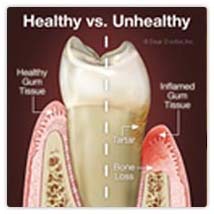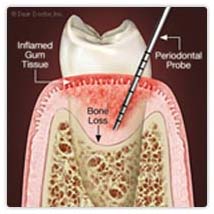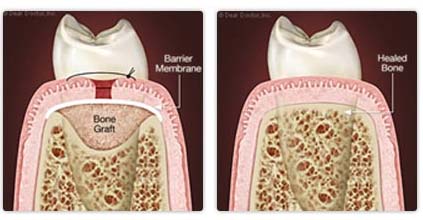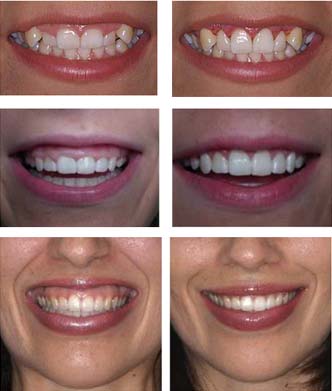Periodontal Treatment
Periodontal Disease also commonly referred to, as Gum Disease is frequently the cause for tooth loss in adults. This disease is closely associated with Heart Disease, Diabetes and Pre-term low birth weight infants when present in pregnant women.
What are symptoms of Gum Disease?
Early symptoms of Gum Disease include gum bleeding without pain. Pain is a symptom of more advanced Gum Disease as the loss of bone around the teeth leads to the formation of gum pockets. Bacteria in these pockets cause gum infection, swelling, pain, and further bone destruction. Advanced Gum Disease can cause loss of otherwise healthy teeth.
If you notice any of the following signs of Gum Disease, schedule an appointment immediately:
- Gums that bleed when you brush your teeth
- Red, swollen or tender gums
- Gums that have pulled away from the teeth
- Bad breath that doesn’t go away
- Pus between your teeth and gums
- Loose teeth
- A change in the way your teeth fit together when you bite
- A change in the fit of partial dentures
Full Mouth Scaling & Polishing
Dental cleanings involve removing plaque (soft, sticky, bacteria film) and tartar (calculus) deposits that have built up on the teeth over time. Your teeth are continually bathed in saliva which contains calcium , phosphorus, flourides and other substances which help strengthen and protect the teeth. While this is a good thing, it also means that we tend to get a build-up of calcium deposits on the teeth. Usually it is tooth coloured and can easily be mistaken as part of the teeth, but it also can vary from brown to black in colour.
If the plaque,or calculus (tartar, as dentists like to call it) is allowed to accumulate on the teeth it will provide the right conditions for bacteria to thrive next to the gums. The purpose of the cleaning and polishing is basically to leave the surfaces of the teeth clean and smooth so that bacteria are unable to stick to them and you have a better chance of keeping the teeth clean during your regular home care.
Commonly used first is an ultrasonic instrument which uses tickling vibrations to knock larger pieces of tartar loose. It also sprays a cooling mist of water while it works to wash away debris and keep the area at a proper temperature. The device typically emits a humming or high pitched whistling sound. This may seem louder than it actually is because the sound may get amplified inside your head, just like when you put an electric toothbrush into your mouth.
Its recommended to visit your dentist every 6 months for then regular check-up & full mouth scaling & polishing.
PERIODONTAL FLAP SURGERY
Gum Diseases Management
Periodontal plastic surgery is designed to restore form and function to the gum tissue, periodontal ligament, and the bone that supports your teeth or an individual tooth. The real long-term goal of any periodontal surgery is to increase the life expectancy of the teeth and their usefulness. Basically, periodontal surgery removes UNHEALTHY tissue that has been transformed by the disease and then reconstructs the gums and surrounding tissues to better support the teeth and to recreate a normal appearance.
Periodontal Disease
Periodontal disease is diagnosed when gingival or gum tissue attachment to the teeth is abnormal and bone changes may be evident through x-rays. A PERIODONTIST will determine the degree of periodontal disease by examining “pockets” between the gum and tooth to see how much ATTACHMENT LOSS exists and then will thoroughly examine the x-rays.
When periodontal disease is detected, first recommendation are a few behavioral changes including an enhanced oral hygiene program, quitting smoking, and possibly some additional lifestyle changes.
A regular and thorough professional tartar or calcified plaque removal program will become an essential part of your oral hygiene routine. Typically this is a painless procedure but, in some extreme cases, pain medication may be required for a few days.
Surgical Therapy /Regenerative Procedures
In cases of severe periodontal disease, surgery will be necessary to repair and regenerate the soft and hard tissues and replace any missing teeth. The goal of surgery is to eliminate pockets between the gum and tooth and attempt to encourage reattachment and normal function and esthetics to the patient.
Procedures that regenerate lost bone and tissue supporting your teeth can reverse some of the damage caused by periodontal disease.
Preventing Periodontal Disease
While steps can be taken to alleviate the ravages of periodontal disease, the best step is prevention. Remove plaque and bacteria through daily brushing, flossing, and regular oral hygiene. Routine visits to a dental professional for cleanings are also essential. Quitting smoking has proven to be very helpful in preventing the onset of periodontal disease.
PERIODONTAL PLASTIC SURGERY
Periodontal Plastic Surgery Procedures
Periodontists are often considered the plastic surgeons of dentistry. If you are looking to improve your smile, a periodontist may be able to help.
Gummy Smile or Uneven Gum Line
Do you feel your teeth look too short and your smile is too gummy or your gums cover too much of some teeth while leaving the others the right length? If so, dental crown lengthening might be the solution for you. During this procedure, excess gum tissue is removed to expose more of the crown of the tooth. Then your gumline is sculpted to give your new smile just the right look.
Exposed Roots
Sometimes gum recession causes the tooth root to become exposed, which makes your teeth look long and can make you look older than you are. This recession can happen as a result of a variety of causes, including periodontal diseases.
Gum graft surgery and other root coverage procedures are designed to cover exposed roots, to reduce further gum recession and to protect vulnerable roots from decay.
Ridge augmentation can fill in this defect recapturing the natural contour of the gums and jaw. A new tooth can then be created that is natural looking, easy to clean and beautiful.
Gums De Pigmentation
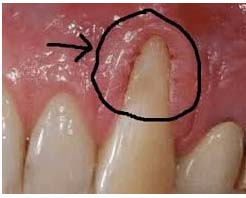 Laser Gum De-pigmentation is generally a dental procedure that is mainly executed to remove the pigments and ugly spots from the gums which is caused due to excessive melanin. Generally, the color of the Gingiva or the gum tissue is pink in color, but due to accumulation of excessive melanin the patient experience ugly patches on gum tissues which is considered to be a cosmetic dental problem. There are several reasons due to which the gum tissue has patches. Using certain synthetic medications for long term and smoking are some common reasons due to which the gum tissues have patches. However, there are several treatments available in dentistry to treat this type of problem. The treatment options include surgical, chemical and laser. In order to get better results, patients may opt for laser gum de-pigmentation. This procedure is not only effective, but also painless and bloodless.
Laser Gum De-pigmentation is generally a dental procedure that is mainly executed to remove the pigments and ugly spots from the gums which is caused due to excessive melanin. Generally, the color of the Gingiva or the gum tissue is pink in color, but due to accumulation of excessive melanin the patient experience ugly patches on gum tissues which is considered to be a cosmetic dental problem. There are several reasons due to which the gum tissue has patches. Using certain synthetic medications for long term and smoking are some common reasons due to which the gum tissues have patches. However, there are several treatments available in dentistry to treat this type of problem. The treatment options include surgical, chemical and laser. In order to get better results, patients may opt for laser gum de-pigmentation. This procedure is not only effective, but also painless and bloodless.
Laser Gum De-pigmentation target and ablate the melanocytes, the cells that produce melanin and cause spots in gingival tissue. Therefore the further production of melanin in gum tissues is reduced significantly. Besides, the laser treatment heals very quickly and can be accomplished in lesser time than other traditional procedures.
The de-pigmentation of gum tissue by using laser is also popular called as laser gum bleaching. This procedure is safe, effective and fast than all other traditional methods. With this procedure gum tissues discoloration can be treated in very less time and without any pain. As this treatment procedure mainly target and ablate melanocytes, so the chance of further production of melanin in gum tissues is eliminated. Besides, this procedure also brings back the natural pink color of the gum tissue.
With laser gum bleaching patients can expect pink gums once again. This treatment is very faster and painless as no surgery is involved in the process. The time required to accomplish this procedure is very less. This procedure hardly consumes few minutes and can be accomplished in a single clinic visit. Thus the need to visiting dental clinic again and again is eliminated.
Laser gum de-pigmentation is a safe procedure as far as protective measures are followed properly by the patients and dentists. But we must remember that it’s not a permanent procedure & some relapse can happen over a few months/years. As in this procedure laser beam is used, so the chance of further damage to the gums and surrounding area is eliminated. Moreover, the possibility of tissue damage and bleeding during the procedure is also eliminated, thus patients can recover at a rapid pace and in better way.


